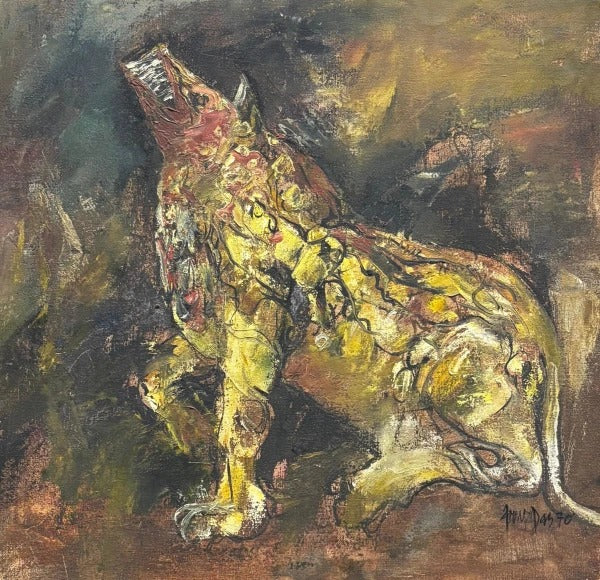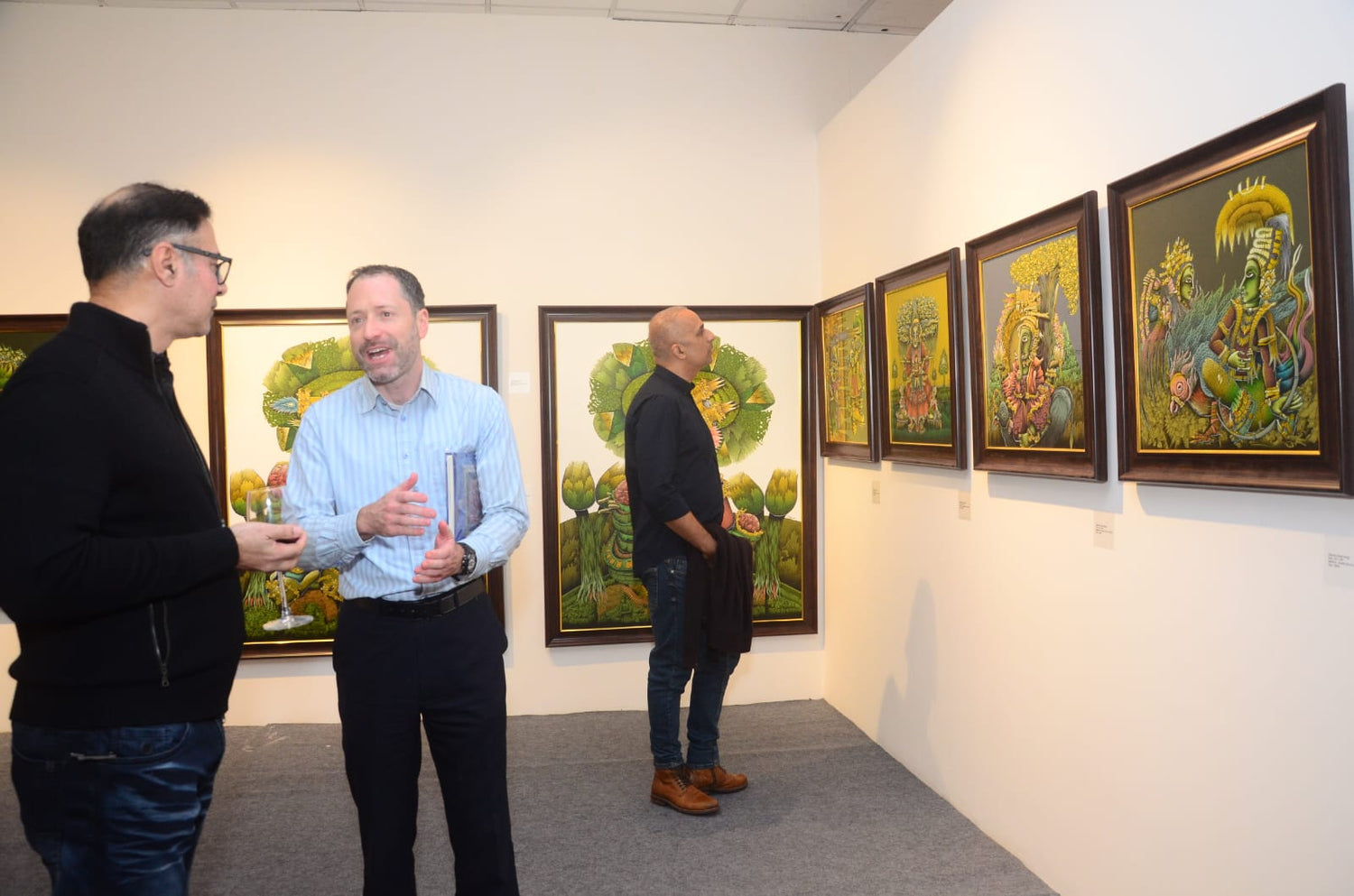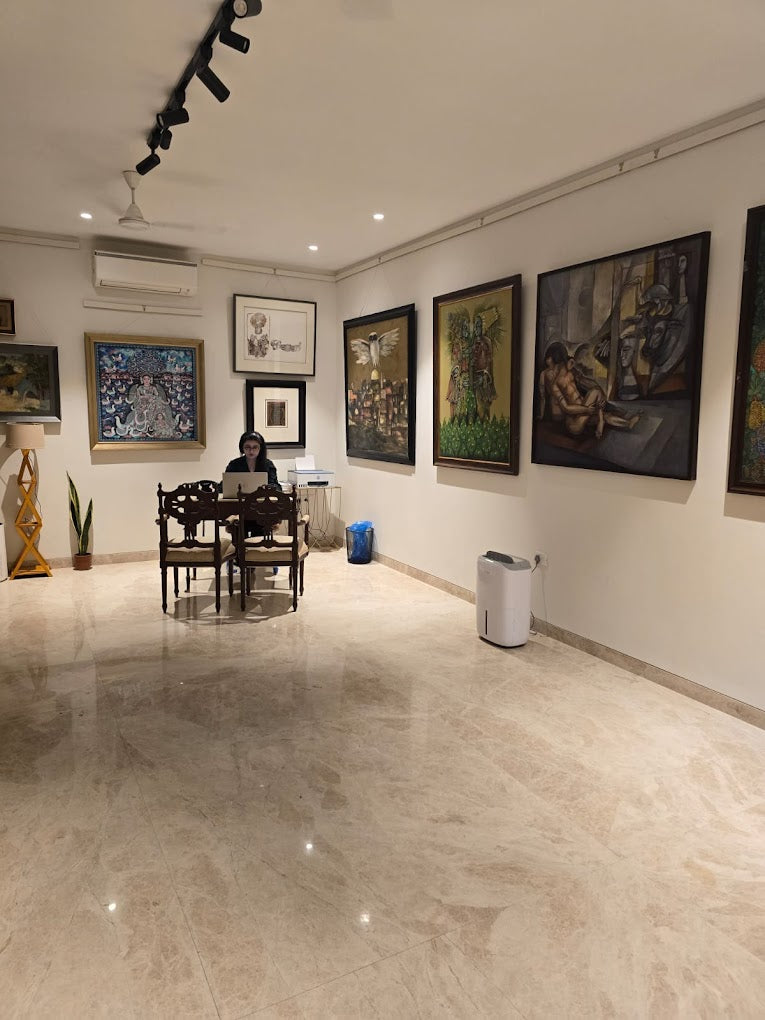Gallery Silver Scpaes
Untitled
Untitled
Couldn't load pickup availability
Artist: Arup Das
Medium: Oil on Canvas
Size: 18 × 18 inches (45.72 × 45.72 cm)
Year: 1970
This evocative painting portrays a creature, seemingly a lion or a similar beast, rendered in a highly expressive, semi-abstract style. The work is rich in texture, dynamic in form, and emotionally charged, demonstrating the artist’s ability to merge raw power with painterly sophistication. The figure of the beast, crouched and roaring upwards, commands the composition. It is not represented in strict realism, but through an amalgamation of vigorous brushstrokes, impasto textures, and distorted anatomy. The dominant hues, ochres, burnt sienna, deep reds, and earthy browns, emphasize both the physical strength and internal torment of the creature. A closer look reveals the artist's intricate layering technique, where colors blend and clash, creating a visceral, almost violent surface that enhances the emotional intensity.
This painting particularly compelling is the tension between the animalistic form and the abstract treatment. The lion is simultaneously recognizable and fragmented. Its head is thrown back in what seems like a howl or roar, conveying anguish, strength, or defiance. The limbs are muscular, yet chaotic, with distorted proportions that resist classical anatomy. The body seems to emerge from, or dissolve into, the background, a swirling environment of shadow, decay, and fire-like tones.
The background does not serve as a simple backdrop; instead, it acts as an extension of the lion’s emotional state. The dark, smoky patches and aggressive swipes of pigment contribute to a sense of unrest and inner turmoil. The indistinct boundaries between figure and ground suggest the lion is both part of and trapped within its world, a metaphor for suffering, struggle, or existential crisis.
This work resonates with expressionist influences, recalling the emotional directness of artists like Francis Bacon or Tyeb Mehta. The focus is not on beauty but on raw feeling, on depicting an emotional truth rather than a literal one. The lion becomes a symbol, perhaps of rage, resistance, or the human spirit caught in the chaos of existence. Signed at the bottom right, the artist's signature anchors the piece, reminding us of the hand behind the creation. The year next to the signature, “1970,” places the work in a period when Indian modernism was thriving with bold experimentation. This painting is a powerful expression of struggle, energy, and catharsis, where the boundaries between form and emotion dissolve into a dramatic visual experience.


Why Choose Us
Art has always, naturally, reflected the development and exploration of different thoughts and perceptions, and our current postmodern era is no different. It is interesting to see how art has evolved visually, yet the traditional methods of composing art remain a valid means of expression.
All it takes for an artist to rise above normalcy, is inspiration, which fuels his passion to paint beautiful creations throughout his life.
The valuable expression of art is always there with us, but now this expression is yet to take an interesting diversion with our art gallery, Gallery Silver Scapes, located in Hauz Khas Enclave. Art is no longer considered just decorative but has evolved and come forth as a major form of investment yielding high rates of returns for its buyers, making it an expression commonly used.

Mrs Mayor was walked into the art world by the legendary modernist Bimal Das Gupta, one of whose biggest collections remains with Gallery Silver Scapes. In the 1980s, as head and first curator of the Habiart Gallery founded by Mrs Rekha Modi — a childhood friend — Mrs Mayor worked closely with and curated shows for renowned artists such as A Ramachandran, GR Santosh, Rameshwar Broota, Sakti Burman, MK Bardhan, Dhiraj Chaudhury, M Sivanesan, and Arup Das among others.
Besides modern masters, she also worked with young contemporaries such as Sudip Roy, Paresh Maity, Subroto Kundu, Vinod Sharma, and many more. Artworks commissioned by her are now part of prestigious collections, such as those of the India Habitat Centre, Ranbaxy, Pepsi, Hotel Lalit, Bank of America, and many more private and public collections.


